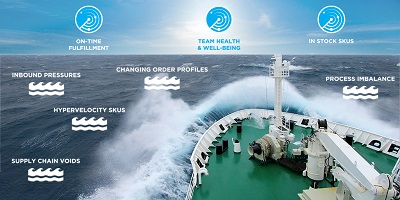Other Voices: 7 operational fulfillment tips for times of need and demand surges
Amidst an unparalleled crisis, a focus on blocking and tackling principles will keep the team healthy, maintain operational effectiveness and keep customer’s orders flowing.
Editor’s note: The following column by Luther Webb, vice president of data science for TREW, is part of Modern’s Other Voices column, a series featuring ideas, opinions and insights from end-users, analysts, systems integrators and OEMs. Click here to learn about submitting a column for consideration.
————-
The deep concern for public health and the unprecedented demand for essential products has left fulfillment centers facing an extraordinary challenge. Implementing best practices for the care and well-being of your team, dealing with hypervelocity SKUs, flipping of order mix, supply chain pressures, and other unique challenges are hitting fulfillment operations while you navigate through the eye of an unparalleled storm.
While the speed and culminating effect of these conditions may be unique and unrivaled, some basic blocking and tackling can help your distribution and fulfillment operations manage successfully. Here are 7 tips to help your team navigate through the storm.
1. Lead and nurture your team
Start with the CDC, WHO and health and safety guidelines and open frequent top-down communication lines to address the constant change and team member concerns. Open additional associate entry points, stagger break times, and develop alternate interior and exterior spaces for lunch to maintain social distancing recommendations. Inspire your teams to be data-intelligent and agile-minded so that decisions can be made quickly and proactively.
2. Get to know your new order profile quickly
Current events can change customer’s shopping habits. What they buy, how much they buy, and when they buy can be very different than normal, leaving your fulfillment operation with a much different order profile (units per line, lines per order, percent of single-line versus multi-line, cube per order, etc.). These changes can cause erratic productivity rates, ebbs and flows in materials, and strains on fixed equipment assets. Quickly get a grasp of these new profiles so that your operations team can use the levers within their fulfillment solution to minimize the disruption and sustain the maximum throughput possible.
3. Re-prioritize your inbound
Work with suppliers, carriers, forwarding agents, and freight brokers to negotiate high priorities on loads with critical products. Use your retail delivery fleet backhaul capacity to pick up priority freight at suppliers. Internally, set aggressive trailer turn and dock-to-slot targets for items in high demand. Use hot SKUs to determine which loads are received first, holding non-essential loads in yard. Leverage Vendor Management Programs and ASNs so that inventories can be updated as soon as the trailer backs into the dock door.
4. Pick-pack and ship from the receiving dock
Bypass the normal moves taken to putaway, retrieve, and stock hypervelocity SKUs that are flying off the shelves. The replenishment moves unnecessarily drive up effort and order cycle times. Instead, identify these items before they arrive and immediately segregate them on the receiving dock and flow the material through a temporary pick-to-ship assembly line. Stage a pallet and then pick, pack, label, and ship using repurposed conveyor (gravity will work). Once packed and labeled, return the items to a pallet for efficient and immediate transportation to the shipping dock.
5. Create ship-alone orders
Many orders, even those with hypervelocity essential products such as masks, gloves, and cleaning supplies, will continue to include a slow-moving SKU on the same order. Split multi-line orders so that higher moving SKUs can bypass order consolidation and ship separately from the medium and slow-moving SKUs on the same order. Evaluate each of the SKUs to determine the possibilities of shipping to the customer in the original container with a simple pick-to-label process. For items that require packing, set up pre-boxing lanes by item cube and form factor to simplify operations.
6. Take large orders offline
During normal operations we often see the large high quantity and multi-line B2B orders, but they are usually infrequent enough that they are a minor hiccup in flow. During times of need and surges in demand, it is likely that these B2B orders are larger and more frequent. Rather than letting them clog batching processes and automation, use your WES or WMS to separate these orders. The orders likely include elevated units per line and higher SKU hit density where they can be picked one at a time, or in small clusters of two to four orders. Once picked, take them directly to a temporary “packing farm” set up specifically to handle these larger orders.
7. Pick cases
With consumers buying larger quantities of individual items, there will be more opportunity to satisfy order lines with full cases. Analyze the size of the opportunity and the SKUs with the highest propensity for full case quantities to get the efficiency advantage of a full case pick. Create a virtual slot for picking full cases for shipping to the customer rather than picking eaches and sending them through consolidation and packing.
During this stormy time, you can use these 7 tips to refocus on blocking and tackling principles to keep your team healthy, maintain your operational effectiveness and keep customer’s orders flowing. How well your operations respond can help set the stage for the next evolution in retail fulfillment, customer experience, and associate satisfaction.
“Courage doesn’t always roar. Sometimes courage is the quiet voice at the end of the day saying ‘I will try again tomorrow.’”
Mary Anne Radmacher, American author and artist













